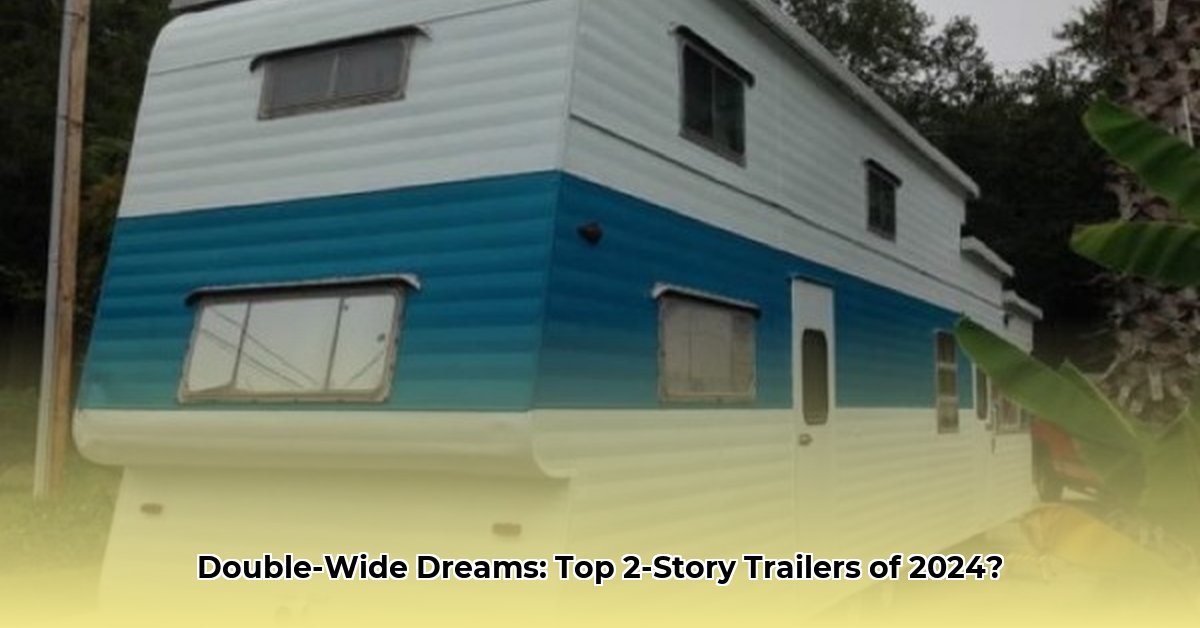Reaching New Heights with Two-Story Manufactured Homes
Dreaming of a spacious home without the hefty price tag of traditional construction? A two-story manufactured home might be your perfect solution. This comprehensive guide covers everything you need to know, from choosing the right floor plan and manufacturer to navigating financing and installation.
Manufactured vs. Modular: Understanding Your Options
Let’s clarify the difference between manufactured and modular homes:
- Manufactured Homes: Built entirely in a factory under HUD code guidelines, these homes are transported to your site complete. This streamlined process often translates to lower costs and quicker move-in times. Think of it like buying a new car – it’s ready to go when you drive it off the lot.
- Modular Homes: Constructed in sections within a factory and then assembled on your property, modular homes offer greater design flexibility. They often rival site-built homes in quality and customization options, but typically come with a higher price tag. Imagine ordering a custom-built computer – you get to choose the components you want.
Both options offer the advantage of factory-controlled construction, leading to consistent quality and potentially faster build times compared to site-built homes. However, modular homes offer more customization flexibility while manufactured homes often come at a lower price point.
Finding the Perfect Floor Plan: Living Your Best Life
Choosing the right floor plan is paramount. Carefully consider your family’s lifestyle and needs:
- Bedrooms and Bathrooms: How many of each do you need?
- Special Spaces: Do you require a home office, playroom, or guest room?
- Kitchen and Living Areas: Do you prefer open-concept living or distinct spaces?
- Accessibility: Are stairs a concern? Consider floor plans with main-floor master suites if mobility is a factor.
Browse online catalogs and visit model homes to visualize different layouts. Don’t hesitate to ask manufacturers about customization options – many offer flexibility within their standard plans.
Choosing a Manufacturer: Reputation and Reliability
Researching manufacturers thoroughly is essential. Look for established companies with a proven track record:
- Online Reviews: Check customer testimonials and reviews on various platforms.
- Industry Reputation: Look for manufacturers with a history of quality construction and good customer service.
- Warranties: Compare warranty offerings and understand what is covered. A comprehensive warranty can offer peace of mind.
- Factory Tours: If possible, visit a factory to see firsthand how the homes are built. This can give you a valuable insight into the quality and construction process.
Reputable manufacturers often have experienced dealers who can guide you through the selection and purchasing process. Don’t hesitate to ask questions and leverage their expertise.
Financing Your Dream: Making it Affordable
Financing a manufactured or modular home differs slightly from securing a traditional mortgage. Explore various options:
- Manufactured Home Specific Loans: Some lenders specialize in financing for manufactured homes.
- Chattel Loans: These loans are secured by the home itself, similar to an auto loan. They may be an option if you own the land outright.
- Conventional Mortgages: These might be available if the home is permanently affixed to a foundation.
Shop around for the best interest rates and loan terms. A strong credit score will improve your chances of securing favorable financing.
Zoning and Regulations: Know Before You Buy
Zoning regulations vary by location. Before purchasing a home, verify that your property meets local requirements:
- Permitted Use: Ensure that manufactured or modular homes are allowed in your area.
- Setback Requirements: Confirm that the home will fit within the required setbacks from property lines.
- Utility Connections: Verify availability of water, sewer, and electrical connections.
Working with a knowledgeable dealer can simplify this process. They are often familiar with local regulations and can assist with obtaining necessary permits.
Pros and Cons: Weighing Your Options
Consider the advantages and disadvantages of two-story manufactured homes:
| Feature | Pros | Cons |
|---|---|---|
| Cost | Often significantly more affordable than site-built homes of comparable size. | Can be more expensive than single-story manufactured homes. |
| Space | Maximizes living area; designated living zones. | Stairs might be a concern for accessibility. |
| Construction Time | Generally shorter build times than site-built homes. | Requires professional installation and site preparation. |
| Customization | Varies by manufacturer; modular homes offer more flexibility. | Less customization than fully site-built homes. |
Cost Considerations: Budgeting for Your Home
The cost of a two-story manufactured home can vary widely based on size, features, and manufacturer:
| Feature | Estimated Cost Range |
|---|---|
| Basic Model | $145,000 – $200,000 |
| Standard Model | $200,000 – $250,000 |
| Premium Model | $250,000 – $300,000+ |
| Land | Market dependent – can be a significant expense. |
| Site Preparation | $5,000 – $15,000+ |
| Transport & Installation | $5,000 – $20,000+ |
Remember that these are estimates, and actual costs may vary. Contact manufacturers and dealers for precise pricing in your area. Factor in land costs, site preparation, and potential customization upgrades to get a complete picture of your total investment.
Top Manufacturers of 2024 (Examples)
While factory-built two-story manufactured homes are less common, some manufacturers may offer customizable multi-story modular homes. Research manufacturers like Clayton Homes, Skyline Homes, and Champion Homes. Contact them directly for up-to-date information on available models, floor plans, and pricing.
Is a Two-Story Manufactured Home Right for You?
A two-story manufactured or modular home offers a unique blend of affordability, space, and convenience. By carefully weighing the pros and cons, researching manufacturers and floor plans, and navigating the financing and zoning processes, you can make an informed decision and find the perfect two-story home to fit your needs and budget. While the availability of true two-story manufactured options may evolve, the principles of maximizing space and value remain constant. This guide empowers you to explore the exciting possibilities of vertical living within the manufactured housing landscape.
- Dora the Explorer Wipe-Off Fun: Safe & Mess-Free Activities for Little Explorers - April 18, 2025
- Does Lemongrass Repel Mosquitoes? Fact vs. Fiction + How to Use It - April 18, 2025
- Do Woodchucks Climb Trees?Fact vs. Fiction - April 18, 2025










